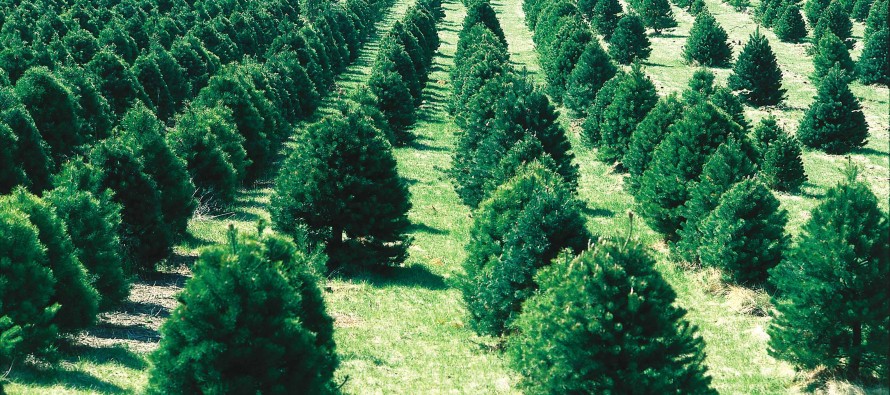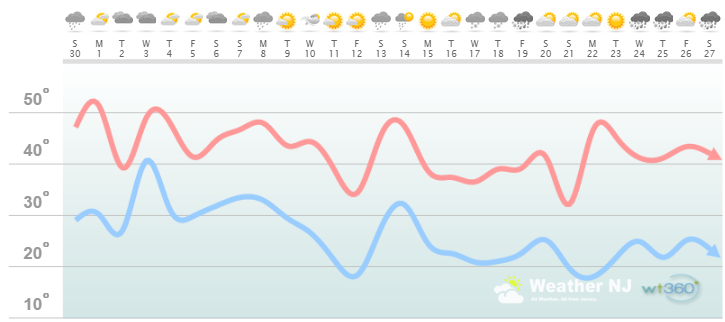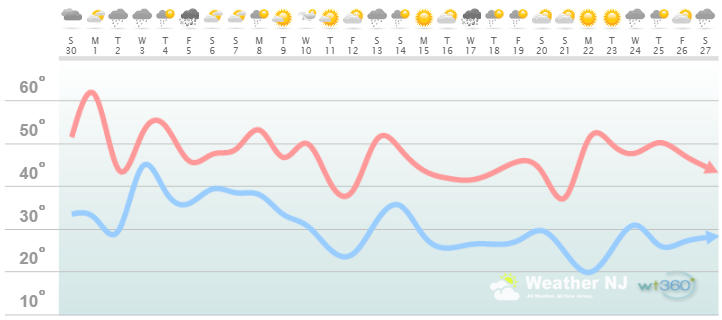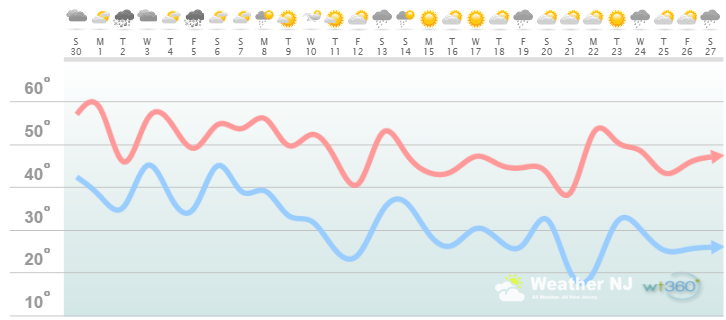NJ Long Range Outlook – Heading into the December Holidays

It’s time to harness the true power of WeatherTrend360’s proprietary algorithms again as we head into December. First lets break New Jersey into proper climatological regions. We have the upper elevations of NWNJ, the interior coastal plain (SWNJ through CNJ and into NENJ), and the coastal regions (most of SENJ). I’ll be representing each climatological region with a 28-day graph from weathertrends360 data followed by a brief discussion. Keep in mind that these algorithms are 84% accurate and are based on oceanic water cycles and time table series. It’s not 100% but better than everything else out there.
Zone 1: Higher Elevations of NWNJ (Sussex, Warren, Hunterdon, Morris, N. Somerset, and N. Passaic) – Known for little to no Atlantic Ocean influence, colder-snowier winters, and drier conditions in general when compared to the coast. This region is known to get hot when high pressure sits overhead during the summer.
Zone 1 Discussion: December looks very jumpy regarding temperatures. You can visually see the ups and downs that occur during 3-4 day transient periods while the overall trend decreases. This tells me that temperatures will fall through the month at an average rate despite the shorter equalizing imbalances. These imbalances often come with frontal passages before and/or after which typically results in precipitation.
My best top-level guess is that December will yield average to slightly above average temperatures simply by averaging all lows and highs over all 31 days. A lower level description would be wild temperature swings between 72 hour transient periods of cold and warmth. Without a solid -NAO high lateral blocking signal, no major snow events are currently expected in the higher elevations of NWNJ. Significant events would have to time and phase perfectly to produce. Not impossible but unlikely for at least the first third/half of December.
Zone 2: Interior Coastal Plain (Salem, Gloucester, Camden, W. Burlington, Mercer, W. Monmouth, Middlesex, Union, Essex, Hudson, Bergen, and S. Passaic) – Known for naturally higher temperatures due to lower elevations away from the oceanic influence. This region is also known as “heat island” due to transportation (I-95 corridor), smog, abundant asphalt, concrete, and other man-made structures that naturally absorb heat (Heat Island).
Zone 2 Discussion: December looks very jumpy regarding temperatures. You can visually see the ups and downs that occur during 3-4 day transient periods while the overall trend decreases. This tells me that temperatures will fall through the month at an average rate despite the shorter equalizing imbalances. These imbalances often come with frontal passages before and/or after which typically results in precipitation.
My best top-level guess is that December will yield average to slightly above average temperatures simply by averaging all lows and highs over all 31 days. A lower level description would be wild temperature swings between 72 hour transient periods of cold and warmth. Without a solid -NAO high lateral blocking signal, no major snow events are currently expected for SWNJ, NENJ or along the general I-95 corridor. Significant events would have to time and phase perfectly to produce. Not impossible but unlikely for at least the first third/half of December.
Zone 3: Coastal Regions (Cumberland, Cape May, Atlantic, E. Burlington, Ocean, and E. Monmouth) – Known for tremendous influence from the Atlantic Ocean. Oceanic influence keeps this zone cooler in the summer and warmer in the winter than the interior coastal plain and especially the higher elevations of NWNJ.
Zone 3 Discussion: December looks very jumpy regarding temperatures. You can visually see the ups and downs that occur during 3-4 day transient periods while the overall trend decreases. This tells me that temperatures will fall through the month at an average rate despite the shorter equalizing imbalances. These imbalances often come with frontal passages before and/or after which typically results in precipitation.
My best top-level guess is that December will yield average to slightly above average temperatures simply by averaging all lows and highs over all 31 days. A lower level description would be wild temperature swings between 72 hour transient periods of cold and warmth. Without a solid -NAO high lateral blocking signal, no major snow events are currently expected for the coastal plain. Significant events would have to time and phase perfectly to produce anything SE of the NJYP/I-95 corridor. Not impossible but unlikely for at least the first third/half of December.
In English: Expect alternating 72-96 hour periods of mild and cold temperatures through December with a slow overall decline in average temperatures. There should be more rain events than snow for lower elevations of New Jersey. Higher elevations of NWNJ always have a better chance of wintry precipitation when temperatures are marginal across the region. For the few cases where colder air and moisture time perfectly, a light-to-moderate winter storm cannot be ruled out. If/when this shows up on model guidance, I’ll be on it!
Weathertrends360 is a complete, global, web solution to help retailers and suppliers capitalize on the weather and its influence on sales and marketing plans up to a year ahead. Learn how to become PROACTIVE vs REACTIVE with the weather in every phase of your business – how much inventory to buy/produce, where to allocate more/less, when to run weather-optimized advertising/marketing campaigns – weathertrends360 can help you determine all of this in minutes! 84% independently audited accuracy for both short-term and year-ahead forecasts for temperature and precipitation.
A forecast Weather Trends issued one year ago is more accurate than every other weather company’s 5 to 14-day forecasts. The University of Miami and West Point PhD Climatologist’s prove WTI’s year-ahead forecasts are several times more accurate than NOAA – Click to Download Report.
Enjoy your December and please be safe! JC
Jonathan Carr (JC) is the founder and sole operator of Weather NJ, New Jersey’s largest independent weather reporting agency. Since 2010, Jonathan has provided weather safety discussion and forecasting services for New Jersey and surrounding areas through the web and social media. Originally branded as Severe NJ Weather (before 2014), Weather NJ is proud to bring you accurate and responsible forecast discussion ahead of high-stakes weather scenarios that impact this great garden state of ours. All Weather. All New Jersey.™ Be safe! JC











